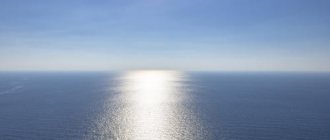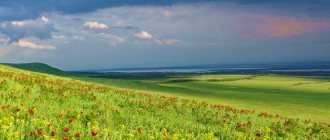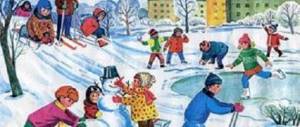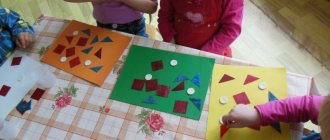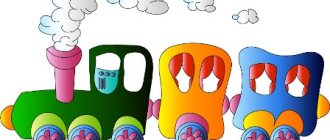Lesson “Population of Africa” lesson plan in geography (grade 7) on the topic
Lesson 29. Population and political map.
Class 7 Date:
Goal: To study the characteristics of the population and its distribution in Africa.
Objectives: teach to name and show areas of high population density and main races; explain the differences between representatives of each race and the principle of population distribution; study the characteristics of the African population; instilling in children a sense of internationalism, equality and brotherhood of all races and nationalities; get acquainted with the political map of the mainland; continue to develop the ability to work with maps and atlases.
Equipment: map “Peoples and population density of the world”; presentation “Population of Africa” (Appendix)
Lesson plan.
- Organizational moment - 3 min;
- Checking homework – 10 min;
- Studying new material – 25 min;
- Consolidation of what has been learned – 5 min;
- Homework – 2 min.
During the classes
- Organizing time.
- Checking homework.
Individual survey on questions.
- Human influence on the nature of Africa.
- Measures to protect the nature of the mainland.
Additional questions are asked by the students themselves. Sample questions:
- Name and show on the map the extreme points of the continent of Africa.
- Name the longest river system in the world.
- Show on the map the inland waters of Africa, etc.
Guys, you talked about how people influence the nature of Africa, how they are trying to save the unique flora and fauna of the continent. Today we will continue to get acquainted with the unique continent of Africa
- Learning new material
What do you think we are talking about if you hear: Berbers, Arabs, Tuaregs, Zulus, Bantu, Ethiopian tribes? (about the population of Africa)
- What will we study in class today? (population of Africa)
- What do you know about the population of Africa? (children answer)
The epigraph of our lesson will be the lines of the modern Ethiopian poet Ayalneh Mulatu (the teacher reads the epigraph)
The name is not so important for the country
And the outlines are not so important,
How important it is who lives in that region,
Why people live and how people live.
Find out any country's special character
We can only recognize her people.
- Why do you think we need knowledge about the peoples inhabiting Africa?
- From what sources of information can you learn about the population?
In today's lesson we will learn what nationalities live in Africa, about the colonial past of the peoples, get acquainted with their culture, listen to a message about the tribes living in Africa.
Questions for the new topic are given on the board. Your task is to answer these questions at the end of the lesson.
Therefore, now read these questions and pay attention while listening to the new topic (student reads aloud).
- Are there differences between black and white people?
- How did slavery affect the population and economy of Africa?
- What peoples live in Africa?
- What are the living conditions and traditions of these peoples?
The topic of our lesson is “Population of Africa”. Let's start by repeating:
- What are the main races of the Earth's population? (Caucasian, Mongoloid, equatorial)
- What external characteristics does each race have? (find and read in the textbook, paragraph 30)
Transfer the diagram to your notebook. Some experts also identify an intermediate race. Look in paragraph 30 for a description of people of this race.
- Population.
Africa is the ancestral home of man. Here, in the rocks, tools and human remains dating back 27 million years were found.
The modern population of Africa belongs to three human races: Caucasoid, Equatorial and Mongoloid.
Among the world religions in Africa, Islam and Christianity predominate. They are professed mainly by the newcomer population. The bulk of the indigenous population remains adherents of traditional African religions.
Africa is home to more than 200 peoples belonging to 16 language families.
Representatives of the Caucasian race live mainly in northern Africa. These are Arab peoples (Algerians, Moroccans, Egyptians) who profess Islam, as well as Berbers who speak the Berber language.
The Cushitic peoples were formed as a result of the mixing of the Caucasian and Equatorial races. Includes Ethiopian, Somali, Amhara peoples.
The largest group is the Bantu peoples. In the south live the Bushmen, Hottentots, who belong to the Mongoloid race, as well as a representative of the equatorial race - Afrikaners.
Most of the continent south of the Sahara is inhabited by Negroids, who make up the African branch of the equatorial race. Among Negroids there are significant differences in skin color, height, facial features, and head shape. For example, the tallest peoples - Tutsis, Maasai, Nilotes - have an average height of 180-200 cm. In the upper Nile region, Negroids are distinguished by very dark, almost black skin color.
The peoples of the equatorial forest zone are pygmies, short in stature (below 150 cm) - this is the smallest people in Africa, whose numbers are steadily declining.
The entire population of Africa is divided into indigenous (people whose ancestors lived in a given area) and newcomers (settlers from other territories)
The newcomer population lives in areas with better climatic conditions: on the Mediterranean coast (these are the French), and in the very south of the mainland - Afrikaners (descendants of immigrants from the Netherlands) and the British.
Many African countries have an ancient culture (Egypt, Ethiopia, Ghana, Sudan). Remarkable monuments of art have been preserved: the Egyptian pyramids - a miracle of construction technology, ivory and wood carvings, bronze sculpture.
Some scientists believe that humanity owes its first successes in the development of culture mainly to Africa.
Students fill out the table “Population of Africa” in their notebooks.
| Race name | Peoples | Place of residence | Character traits |
| 1.Caucasian race | Algerians, Moroccans, Egyptians, Berbers | North Africa | Dark skin, dark hair and eyes, long skull, narrow nose and oval face |
| 2. Equatorial race (Negroid) | Tutsis, Nilotes, Maasai Pygmies | Savannahs in the northern part of the continent Equatorial forest zone | Very dark, almost black skin, height 180-200 cm Less dark skin, thin lips, wide nose, stocky, short (150 cm) |
| 3. Mongoloid | Bushmen, Hottentots | Semi-deserts, deserts | Tan skin color, wide flat face |
| 4.Intermediate race | Ethiopians Malagasy | O. Madagascar | Lighter skin, but with a reddish tint. Mixture of Mongoloid and Negroid races. |
- The mainland's colonial past
Colonization of the mainland began in the Middle Ages. By the beginning of the 20th century, almost the entire territory of Africa was divided among the capitalist countries of Europe, turning Africa into a continent of colonies (countries deprived of political and economic independence).
The colonialists oppressed and exploited the indigenous population, took away the best lands, and drove them from their homes to places unsuitable for life.
They mercilessly plundered countries: they exported minerals, timber, and agricultural products.
The long domination of colonial countries delayed the economic and cultural development of African countries.
In the mid-20th century, Africa became the continent of national liberation struggle. Now all countries on the mainland are independent. Despite this, in many African countries people continue to die from hunger and disease.
Northeast African coast enters arc of instability
- Population distribution
- Remember what the population of the Earth is? (7 billion people)
The population of Africa is about 1 billion people.
- Open the map “Population density. Peoples" pp. 18-19 of the atlas. Find on the map the areas with the highest population density. What color are these areas indicated on the map? (brown)
The most densely populated areas are the northern regions of the mainland and the coast of the Gulf of Guinea.
- What parts of Africa are not inhabited? In the Sahara Desert the density is very low and there are uninhabited areas.
Working on the map “Population density. Peoples."
- What is the proportion of nations whose population is less than 10 million people? (12%)
- Find and name on the map cities with a population of 5 to 10 million inhabitants. (Cairo, Lagos, Kinshasa)
- Find and name cities on the map with a population of 1 to 5 million inhabitants. (Dakar, Conakry, Abidjan, Accra, Brazzaville, Luanda, Cape Town, Maputo, Harare, Dar Es Salaam, Addis Ababa, Algiers, Tripoli)
- The map shows that most of the cities are located on the coast. What is this connected with? (The most favorable natural conditions)
- What reasons do you think influence the placement of the continent? (Population distribution is influenced mainly by natural factors, as well as historical reasons, primarily the impact of the slave trade and colonial rule.)
- Consolidation of what has been learned
- What factors influence the distribution of the mainland's population?
- Indicate the areas with the lowest and highest population density.
- Why don't the pygmies build permanent dwellings?
- Describe the clothing of the Tuaregs, explain the appearance of such national characteristics of clothing.
- Describe the races of Africa.
- Homework: § 30; indicate on the contour map the areas of residence of the main races of Africa. Give two students a task: using the text of the textbook and additional information on four states (Algeria, Nigeria), prepare reports for the next lesson.
Lesson summary on the topic “Peoples of Africa”; 7th grade
Lesson summary on the topic: “Peoples of Africa”, grade 7, within the framework of the Second Generation standards with prescribed, formed UUD for each type of work at all stages of the lesson. A sample handout is attached to the summary.
Purpose of the lesson: Formation of students' understanding of the population of Africa Learning outcome: Subject:
- continued development of the knowledge system about the planet's population;
- the use of geographical skills in identifying the characteristics of the racial, ethnic and religious composition of the population of African countries;
- forming an idea of the degree of influence of the colonial regime on the political picture of the continent;
- the ability to give examples of human adaptation to environmental conditions, population distribution and its influence on the cultural characteristics of peoples
Personal: -ethical component (continuing the formation of tolerance and understanding of the existence of other nationalities, their way of life, culture and traditions; fostering equal attitudes towards different peoples of the world); -aesthetic component (formation of a positive perception of elements of the culture of another people (traditions, rituals, etc.); -educational component (demonstration of the peculiarities of nurturing the character traits of different peoples); Meta-subject: - improving the skills and abilities of working with sources of information: textbook text, diagrams, supporting notes, atlas maps, contour maps; - development of logical thinking (based on students’ assimilation of cause-and-effect relationships between the components of nature, historical aspects, economic factors of African countries); - development of the ability to correctly formulate their thoughts in the process of summarizing the information received; - development ability to analyze, classify and generalize facts and phenomena; -development of the ability to practically use the information received in the process of generalizing and consolidating the material covered;
Teacher Resources:
- textbook, geographical atlas, computer, multimedia projector (hardware), electronic and video lesson materials, visual materials
Resources for students:
- textbook, geographical atlas, handouts, outline maps, pencils, visual materials
Lesson type: combined
Lesson structure:
- Organizational moment (preparing the workplace, primary goal setting): 1-2 minutes;
- Checking d/z: 6 min;
- Learning a new topic: 17 min;
- Summarizing and consolidating new material covered in the lesson: 10-13 min;
- D/W: 2 min;
Scientific and methodological content of the lesson:
- Africa is considered the ancestral home of modern man
- The population of African countries is characterized by a diversity of racial, religious, and ethnic compositions
- The location and density of the continent's population is determined by the characteristics of natural, historical and economic factors
- The political map of Africa is complex and historically unstable
- The uniqueness and identity of African countries is determined by many national hobbies and traditions
Geonomenclature: Africa, Atlantic Ocean, Indian Ocean, Madagascar, Gulf of Guinea, Mediterranean Sea.
Full text of the material Lesson notes on the topic “Peoples of Africa”;
For grade 7, see the downloadable file . The page contains a fragment.
| Author: Petrova Victoria Nikolaevna → Lehrerin6347 05/20/2014 3 5627 965 | Comment |
Thank you for your mark. If you want your name to be known to the author, log in to the site as a user and click Thank you again. Your name will appear on this page.
Login | Registration
Have an opinion? Leave a comment
